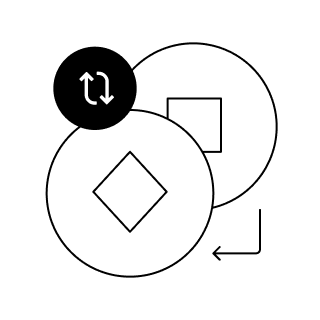What’s Toncoin (TON)? How can I buy it?
What is Toncoin?
Toncoin (TON) is the native cryptocurrency of The Open Network (TON), a high-performance, layer-1 blockchain originally conceived by the team behind Telegram and later developed by an open-source community after regulatory hurdles halted Telegram’s direct involvement. TON is designed to support massive scale for consumer applications, including payments, decentralized storage, domain services (TON DNS), identity, and a broad suite of decentralized applications (dApps)—all tightly integrated with the user experience of Telegram’s global messaging ecosystem through bots and mini apps.
Core goals of TON:
- High throughput and low latency suitable for mainstream use cases
- Minimal fees for microtransactions and remittances
- Seamless onboarding with familiar UX (e.g., Telegram wallet integrations)
- Horizontal scalability via dynamic sharding to support hundreds of millions of users
TON’s ecosystem now includes:
- TON Blockchain: A sharded, Proof-of-Stake (PoS) L1
- TON Payments: Off-chain payment channels for instant micropayments
- TON DNS and TON Sites: Human-readable names and web-like hosting for decentralized resources
- TON Storage: Content-addressed, distributed storage layer
- TON Services: A framework for dApps and service integrations inside Telegram
How does Toncoin work? The tech that powers it
TON’s architecture focuses on parallelism, scaling, and user-friendly abstractions without sacrificing security. Key components include:
- Multi-chain architecture and dynamic sharding
- Masterchain, workchains, shardchains:
- Masterchain stores global configuration, validator sets, and network metadata.
- Workchains can have different rules or virtual machines (VMs), enabling specialization.
- Each workchain is split into shardchains, which can split and merge dynamically (“dynamic sharding”) to balance load.
- Parallelism:
- Transactions are processed across many shardchains in parallel.
- Cross-shard communication uses asynchronous message passing with cryptographic receipts for finality and ordering.
- Consensus: Proof-of-Stake with BFT-style finality
- Validators stake TON to participate in block production.
- Blocks are proposed and validated using a Byzantine Fault Tolerant mechanism, targeting rapid finality and high throughput.
- Slashing:
- Misbehaving validators risk losing stake, aligning incentives for honest participation.
- Elections and rotations:
- Validators are periodically elected and rotated, improving decentralization and resilience.
- TON Virtual Machine (TVM) and smart contracts
- TVM executes smart contracts written in specialized low-level languages (e.g., FunC) and higher-level toolchains.
- Actor model:
- Each contract is an “actor” with its own state, communicating via messages.
- The model maps naturally to sharded execution and asynchronous calls, enabling scalable application design.
- Gas model:
- Deterministic gas accounting ensures resources are bounded and fees are predictable.
- Persistent data cells:
- TON uses a “cell” structure (Merkle-like) for compact, verifiable on-chain data, enabling efficient proofs and state operations.
- TON Payments and off-chain channels
- Payment channels allow instant, low-fee micropayments off-chain, settling on-chain when channels close.
- This reduces mainchain load and supports real-time commerce and tipping inside apps like Telegram.
- TON Storage and TON Sites
- TON Storage:
- Distributed, content-addressable storage similar in spirit to IPFS; incentivized via TON payment mechanisms.
- TON Sites and TON DNS:
- Human-readable .ton domains map to smart contracts and resources.
- TON Sites serve content via decentralized hosting, discoverable by TON DNS, aiming for a web-like UX without central points of failure.
- Interoperability and developer tooling
- Bridges:
- Community and partner projects maintain bridges to ecosystems like Ethereum and BNB Chain, enabling asset transfers.
- SDKs and languages:
- Tooling supports FunC, Tact, and frameworks for building bots/minis inside Telegram, lowering the barrier for consumer-facing dApps.
What makes Toncoin unique?
- Deep integration with Telegram’s user base:
- TON leverages Telegram’s mini apps, bots, and wallet integrations, dramatically simplifying onboarding and distribution for dApps. This “distribution-first” approach is rare among L1s.
- Dynamic sharding at L1:
- TON was designed from inception to scale horizontally through automatic shard split/merge, aiming for sustained throughput as usage grows without relying solely on L2s.
- Asynchronous, message-driven architecture:
- Smart contracts communicate via messages across shards/workchains, naturally aligning with parallel execution and global scale.
- Consumer UX focus:
- Features like TON DNS, TON Sites, and on-ramps within familiar apps enable web2-like flows for web3 services.
- Comprehensive “stack” vision:
- Beyond a chain and VM, TON includes payments, storage, and naming—positioning it as a full-stack decentralized platform for mainstream apps.
Toncoin price history and value: A comprehensive overview
Note: Cryptocurrency markets are volatile. Always verify current data from reputable sources (e.g., CoinGecko, CoinMarketCap, Kaiko, Messari, The Open Network Foundation communications, and major exchanges).
- Early distribution and revival:
- TON originated from Telegram’s “GRAM” project. After the 2020 SEC settlement, Telegram stepped back; the community continued development under “TON” (The Open Network), with Toncoin as the native asset.
- Exchange listings and ecosystem traction:
- As the TON community shipped core features and Telegram-related integrations matured (e.g., wallet bots, mini apps), TON gained listings on major exchanges, improving liquidity and price discovery.
- Catalysts that have historically influenced price:
- User growth via Telegram integrations and viral mini-apps/games
- Bridge deployments and DeFi primitives launching on TON
- Validator incentives, staking yields, and lockups affecting float
- Partnerships, ecosystem grants, and developer growth
- Market-wide cycles impacting L1 valuations
Value drivers to watch:
- On-chain activity: daily active addresses, transactions per second, fees
- dApp traction: payments, gaming, SocialFi, and mini apps leveraging Telegram
- Staking metrics: percentage staked, validator decentralization
- Interop/bridges: TVL of wrapped assets and cross-chain flows
- Regulatory posture and exchange coverage
Is now a good time to invest in Toncoin?
This is not financial advice. Consider the following framework:
Positives:
- Distribution edge: Direct access to Telegram’s massive user base is a unique adoption vector.
- Scalability design: Dynamic sharding and message-driven architecture target long-term throughput.
- Low-friction UX: Wallets, bots, and DNS/Sites reduce onboarding friction for mainstream users.
- Ecosystem momentum: Growth in mini apps, payments, and on-ramps can translate to real usage.
Risks:
- Market cyclicality: L1 tokens are highly sensitive to macro crypto cycles and liquidity.
- Execution risk: Sustaining high throughput, robust dev tooling, and security across shards is complex.
- Regulatory uncertainty: Jurisdictional policies on consumer crypto apps can shift.
- Competition: Other high-throughput L1s and modular stacks (L2s/rollups) are innovating rapidly.
Due diligence checklist:
- Review the TON whitepaper, technical papers, and validator documentation.
- Track on-chain metrics (active addresses, fees, transactions, staking ratio).
- Assess ecosystem health: number of high-quality apps, developer activity, TVL, bridge security audits.
- Understand tokenomics: issuance, validator rewards, inflation, treasury, and lockup schedules.
- Diversify and size positions prudently; consider staking for yield if appropriate and secure.
Time horizon:
- TON’s adoption thesis hinges on consumer-scale apps. If you believe Telegram-native mini apps and payments will onboard the next wave of users, a long-term horizon may be more appropriate than short-term trading.
Sources and further reading
- The Open Network (TON) documentation and whitepapers: docs.ton.org
- TON Foundation announcements and ecosystem updates: ton.org and foundation channels
- Technical overviews by reputable researchers (e.g., Messari profiles, CoinGecko/CoinMarketCap research pages)
- Security audits and validator docs in TON GitHub repositories
- Exchange research desks and independent analytics providers (Kaiko, IntoTheBlock) for market data and liquidity analysis
Discover the different ways to buy crypto

Make informed decisions










